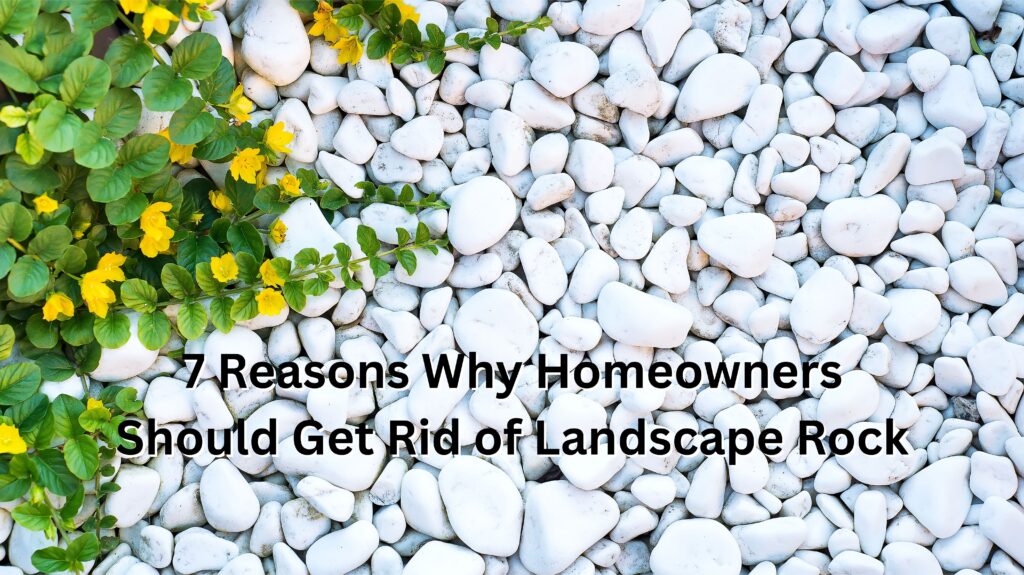Table of Contents
📝 Introduction
1. Elevated Heat Stress on Plants
Rocks act like mini heat sinks, absorbing the sun’s warmth all day and radiating it back into the soil at night. This constant warmth might be fine for cacti and succulents, but for most ornamental plants, shrubs, and flowers, it’s a stress factor. Roots can overheat, causing plants to require more water and struggle during hot summers. Over time, this heat stress may shorten a plant’s lifespan or stunt its growth.
Example: In a sunny front yard bed, black lava rock can raise surrounding soil temperatures by up to 15°F compared to mulch—turning a lush garden into a dry, thirsty space by midsummer.
2. Alters Soil pH—Harmful to Certain Plants
Many landscape rocks—particularly limestone or other carbonate-rich stones—can leach minerals into the soil, slowly increasing its alkalinity. Acid-loving plants like azaleas, rhododendrons, and hydrangeas may become nutrient-deficient in these conditions. This pH shift can also subtly affect nearby lawn areas, leading to uneven growth patterns.
Tip: If you’ve noticed your acid-loving plants developing yellow leaves (chlorosis) despite proper care, alkaline runoff from rocks could be the culprit.
3. No Nutrients Provided to the Soil
4. Weeds Eventually Find a Way
Rocks may slow weeds at first, but over time, airborne seeds, fallen leaves, and soil blown in by the wind create the perfect germination bed between stones. When weeds do appear, they’re harder to pull because their roots grow down through the rock layer and landscape fabric.
Frustrating scenario: You spend hours removing rocks just to get to the base of stubborn crabgrass or dandelions that have anchored deep into the soil.

5. Hard to Remove for Landscape Changes
6. Landscape Fabric & Soil Health Issues
7. Difficult to Keep Clean
Leaves, twigs, and seasonal debris are inevitable. Unfortunately, rocks are far more difficult to keep clean than mulch. You can’t just rake leaves off without scattering the stones, and over time, organic debris builds up between rocks, contributing to weed problems and attracting pests.
Example: In autumn, rock beds under a maple tree can become littered with hundreds of leaves, and cleaning them without disturbing the rock layer is almost impossible without specialized equipment.
Pros and Cons of Landscape Rock
Pros
Low Maintenance at First – Rock doesn’t need to be replaced yearly like mulch and doesn’t break down.
Durable & Long-Lasting – Once installed, it can last for decades without much visible wear.
Excellent Erosion Control – Heavy stones can help prevent soil washout on slopes.
Fire-Resistant – Ideal for fire-prone regions where mulch could be a hazard.
Variety of Styles & Colors – Available in multiple sizes, shapes, and shades to complement different landscapes.
Want a deeper comparison between these two popular landscaping materials? Check out our Rocks vs. Mulch: Which is Better Around Your House? for side-by-side pros, cons, and maintenance tips.
Cons
Increases Soil Temperature – Retains and radiates heat, potentially harming plants.
Alters Soil pH – Can increase alkalinity, making it unsuitable for certain plants.
No Soil Enrichment – Provides zero nutrients to the soil.
Weeds Will Still Appear – Over time, debris buildup allows weeds to grow.
Difficult to Clean & Maintain – Debris removal is tedious and time-consuming.
Hard to Remove for Changes – Heavy and labor-intensive to clear out if you redesign your yard.
May Complicate Soil Health – Often paired with landscape fabric, which can restrict airflow and water penetration.
Still on the fence about making the switch? Watch our 3 Reasons to Remove Rock and Install Mulch (Tutorial Videos) for a visual guide showing why mulch can be the better long-term choice for your landscaping.



